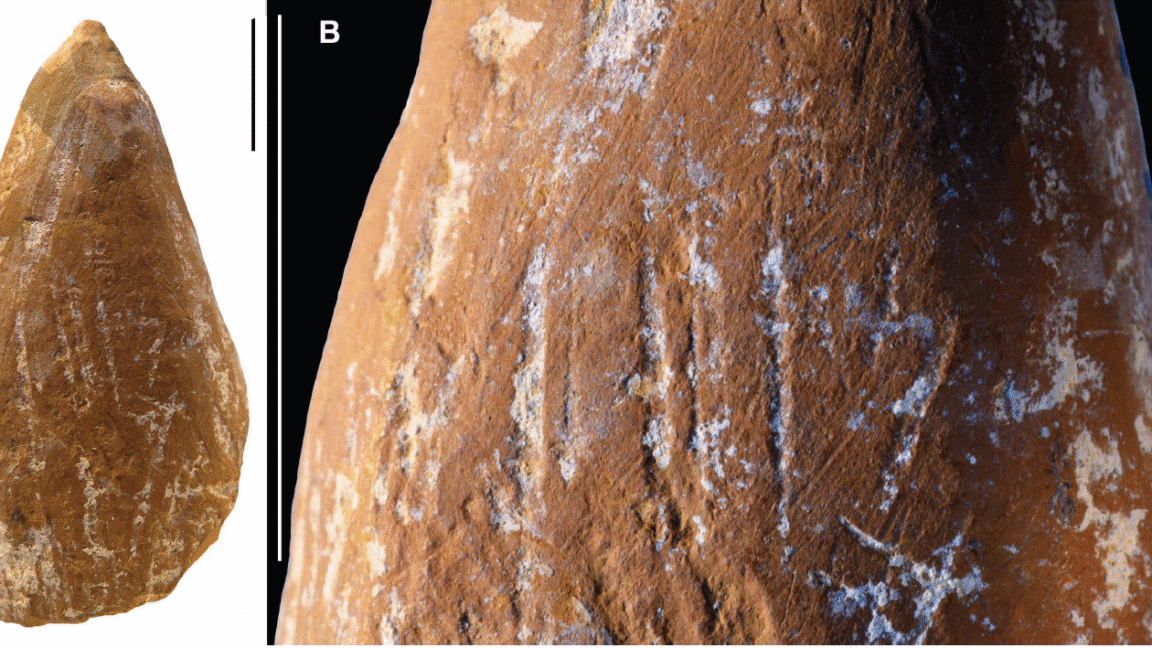Science
Neanderthals Used Ocher as Crayons, Study Reveals Artistic Skills

Recent research suggests that Neanderthals crafted ocher into crayons, revealing their artistic capabilities. Archaeologists discovered two ocher pieces at ancient rock shelters in Crimea, Ukraine, dating back approximately 47,000 and 46,000 years. The artifacts displayed signs of deliberate shaping and repeated resharpening, indicating their use for marking or drawing.
The archaeological sites near modern-day Bilohirsk have yielded numerous ocher fragments, which are rich in iron oxide. Many of these fragments show wear patterns consistent with their use as pigments. Dr. Francesco D’Errico and his team utilized advanced imaging techniques, including X-ray fluorescence and scanning electron microscopy, to analyze 16 ocher chunks, uncovering significant insights into Neanderthal behavior.
These ocher artifacts were not merely functional; two specifically shaped pieces from the site known as Zaskalnaya V hinted at artistic intent. One piece, measuring 44.8 millimeters in length, was shaped into a pointed tool, while another fragment, 25.4 millimeters long, exhibited similar characteristics but had a broken tip. D’Errico stated, “The combination of shaping, wear, and resharpening indicates they were used to draw or mark on soft surfaces.”
A third ocher fragment revealed a more intricate design. It featured several deep, parallel lines carved into its surface, suggesting it was handled with care and possibly transported. D’Errico noted the polished nature of the lines, indicating long-term use. The orientation of the incisions suggests the carver was right-handed.
The findings contribute to a growing body of evidence demonstrating that Neanderthals engaged in cultural practices that extended beyond mere survival. Historically viewed as lacking cognitive complexity, the Neanderthals of Crimea exhibited behaviors that indicate a rich cultural life, as emphasized by D’Errico and his colleagues in their paper published in Science Advances.
Neanderthal art capabilities extend beyond these ocher crayons. They have been linked to other significant archaeological discoveries, including 57,000-year-old finger markings in France and ocher-painted shells dating back 114,000 years in Spain. These discoveries collectively challenge the traditional perception that Neanderthals lacked symbolic thought or creativity.
D’Errico’s team suggests that the long-term use of ocher implies a symbolic dimension to its application. The varied colors and shades of ocher may have held specific meanings for Neanderthals, just as colors do in contemporary cultures. This variability points to the possibility of distinct cultural trajectories among Neanderthal groups, which could involve community traditions and long-distance exchanges.
The implications of these findings are profound. The evidence continues to support the idea that Neanderthals were innovative and capable of creative expression. Their use of ocher for artistic purposes suggests that the impulse to create art is deeply rooted in our evolutionary history.
In summary, the study of ocher artifacts from Crimea reveals that Neanderthals were not only skilled toolmakers but also capable of artistic expression. These findings invite further exploration into the cognitive and cultural lives of Neanderthals, enhancing our understanding of humanity’s shared heritage.
-

 Education3 months ago
Education3 months agoBrandon University’s Failed $5 Million Project Sparks Oversight Review
-

 Science4 months ago
Science4 months agoMicrosoft Confirms U.S. Law Overrules Canadian Data Sovereignty
-

 Lifestyle3 months ago
Lifestyle3 months agoWinnipeg Celebrates Culinary Creativity During Le Burger Week 2025
-

 Health4 months ago
Health4 months agoMontreal’s Groupe Marcelle Leads Canadian Cosmetic Industry Growth
-

 Technology3 months ago
Technology3 months agoDragon Ball: Sparking! Zero Launching on Switch and Switch 2 This November
-

 Science4 months ago
Science4 months agoTech Innovator Amandipp Singh Transforms Hiring for Disabled
-

 Education3 months ago
Education3 months agoRed River College Launches New Programs to Address Industry Needs
-

 Technology4 months ago
Technology4 months agoGoogle Pixel 10 Pro Fold Specs Unveiled Ahead of Launch
-

 Business3 months ago
Business3 months agoRocket Lab Reports Strong Q2 2025 Revenue Growth and Future Plans
-

 Technology2 months ago
Technology2 months agoDiscord Faces Serious Security Breach Affecting Millions
-

 Education3 months ago
Education3 months agoAlberta Teachers’ Strike: Potential Impacts on Students and Families
-

 Science3 months ago
Science3 months agoChina’s Wukong Spacesuit Sets New Standard for AI in Space
-

 Education3 months ago
Education3 months agoNew SĆIȺNEW̱ SṮEȽIṮḴEȽ Elementary Opens in Langford for 2025/2026 Year
-

 Technology4 months ago
Technology4 months agoWorld of Warcraft Players Buzz Over 19-Quest Bee Challenge
-

 Business4 months ago
Business4 months agoNew Estimates Reveal ChatGPT-5 Energy Use Could Soar
-

 Business3 months ago
Business3 months agoDawson City Residents Rally Around Buy Canadian Movement
-

 Technology2 months ago
Technology2 months agoHuawei MatePad 12X Redefines Tablet Experience for Professionals
-

 Business3 months ago
Business3 months agoBNA Brewing to Open New Bowling Alley in Downtown Penticton
-

 Technology4 months ago
Technology4 months agoFuture Entertainment Launches DDoD with Gameplay Trailer Showcase
-

 Technology4 months ago
Technology4 months agoGlobal Launch of Ragnarok M: Classic Set for September 3, 2025
-

 Technology4 months ago
Technology4 months agoInnovative 140W GaN Travel Adapter Combines Power and Convenience
-

 Science4 months ago
Science4 months agoXi Labs Innovates with New AI Operating System Set for 2025 Launch
-

 Top Stories2 months ago
Top Stories2 months agoBlue Jays Shift José Berríos to Bullpen Ahead of Playoffs
-

 Technology4 months ago
Technology4 months agoNew IDR01 Smart Ring Offers Advanced Sports Tracking for $169










